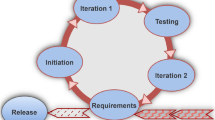Abstract
Most innovations have contextual pre-cursors that prompt new ways of thinking and in their turn help to give form to the new reality. This was the case with the e-scape software development process. The origins of the system existed in software components and ideas that we had developed through previous projects, but the ultimate direction we took with e-scape evolved through a sometimes scary but always fascinating collaboration with TERU at Goldsmiths University of London. The literature refers to ‘agile development’ (Highsmith 2002) and it is certainly a good name for the process we undertook with TERU. It is tempting to believe that one can specify a system, agree it with the clients, and then build it. But not so, … or at least not so in this case. We of course did draw up detailed specifications, but as soon as we started to build it, we or the TERU team would see how much better it could be if only we could just …. In the end, understanding of what is required evolves as the understanding of what is possible develops. So specifications morphed from do-able to maybe; from the firm ground of known technologies to the more shaky territory of the half-known and the “I’ve read about that somewhere”. But the underlying reality was always time and money. The system had to work robustly with enough time ahead of the national pilots for the TERU team to do all the necessary trials and training in schools. And it had to be done within fixed costs agreed at the outset. In this paper I outline the principal challenges that we met along the way and summarise our approach to resolving them.




Similar content being viewed by others
References
Alfonseca, E., & Perez, D. (2004). Automatic assessment of students’ free-text answers underpinned by the combination of a BLEU-inspired algorithm and latent semantic analysis. http://ontotext.fbk.eu/Publications/FlairsFinal.pdf, https://www.aaai.org/Papers/FLAIRS/2005/Flairs05-059.pdf.
Baird, D., & Fisher, M. (2005). Neomillennial user experience design strategies: Utilizing social networking media to support “always on” learning styles. Journal of Educational Technology Systems, 34(1), 5–32.
Barrett, C. (2004). Electronic portfolios as digital sories of deep learning. http://electronicportfolios.com/digistory/epstory.html.
Beck, K., Beedle, M., Van Bennekum, A., Cockburn, A., Cunningham, W., & Fowler, M., et al. (2001). Principles behind the Agile Manifesto. Agile Alliance. http://www.agileAlliance.org.
Craig, E. M. (2007). Changing paradigms: Managed learning environments and Web 2.0. Campus-Wide Information Systems, 24, 152–161.
Ford, J., Smith, E., Weissbein, D., Gully, S., & Salas, E. (1998). Relationships of goal orientation, metacognitive activity, and practice strategies with learning outcomes and transfer. Journal of Applied Psychology, 83(2), 218–233.
Gartner. (2010). Competitive landscape: Mobile devices, Worldwide, 4Q09 and 2009. http://www.gartner.com.
Highsmith, J. (2002). Agile software development ecosystems. Boston, MA, USA: Addison-Wesley Longman Publishing Co., Inc.
Joos, I. M., Joos, I. M., Nelson, R., & Smith, M. (2009). Introduction to computers for healthcare professionals. London: Jones and Bartlett Publishers.
Kimball, M. (2005). Database e-portfolio systems: A critical appraisal. Computers and Composition: An International Journal, 22(4), 434–458.
Kimbell, R. (2010). Performance portfolios: Problems, potential and policy. In M. de Vries & A. Jones (Eds.), International handbook of research and development in technology education. Rotterdam: Sense Publishers.
Kuhn, D. (2000). Metacognitive development in current directions. Psychological Science, 5(9), 178–181.
Lin, J., & Paul, S. (1996). RMTP: A reliable multicast transport protocol. West Lafayette, IN: Dept of Comput. Sci, Purdue Univ.
Mason, R., & Rennie, F. (2008). E-learning and social networking handbook. New York: Routledge.
Queiros, R., Oliviera, L., Silva, C., & Pinta, M. (2011). Interoperability on e-Learning 2.0: The PEACE case study. Communications in Computer and Information Science, 220(3), 276–285.
Wharfe, W., & Derrick, K. (2005). Tracking capability using web-based ePortfolios in UK schools. Handbook of Research on ePortfolios, 378–387.
Ye, L., Su, X., & Yan, H. (2009). The development of the Distance Education College of East China Normal University: A case study. Campus-Wide Information Systems, 26(2), 108–113.
Author information
Authors and Affiliations
Corresponding author
Rights and permissions
About this article
Cite this article
Derrick, K. Developing the e-scape software system. Int J Technol Des Educ 22, 171–185 (2012). https://doi.org/10.1007/s10798-011-9193-1
Published:
Issue Date:
DOI: https://doi.org/10.1007/s10798-011-9193-1




